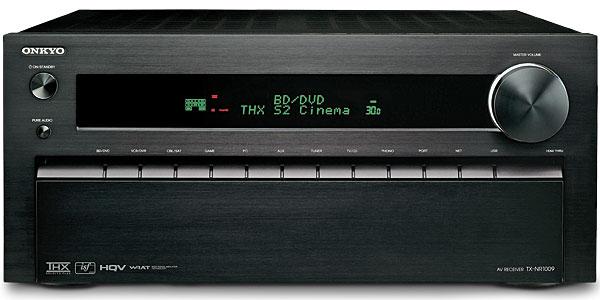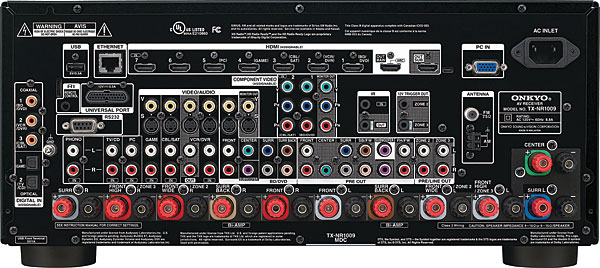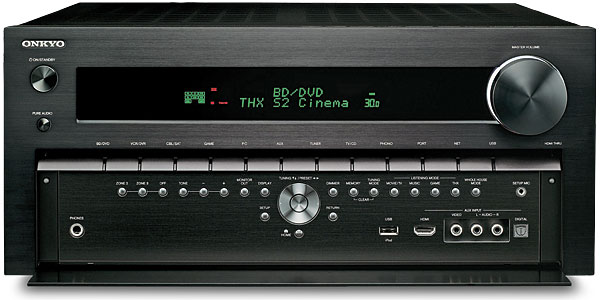Onkyo TX-NR1009 9.2-Channel Network A/V Receiver

When one looks to upgrade an AVR, one must take much into consideration: features, number of inputs and outputs, multizone capability, channels of amplification, power rating, and, of course, cost. The sub-$1,000 market is loaded with AVRs that offer a terrific value but lack many of the bells and whistles that are found once you cross the $1,000 barrier, such as multizone, nine channels of amplification, and more HDMI inputs than the average person will ever need.
Onkyo AVRs run the gamut from the entry-level TX-NR309 ($299) up to the flagship TX-NR5009, which will set you back $2,899. The TX-NR1009, priced at a relatively modest $1,399, rests near the top of its waterfall and is the lowest-priced model with nine channels of amplification. It’s also the first AVR on the market to offer DTS Neo:X processing. Does it offer enough bang for the buck versus its lower-cost siblings and enough higher-end features to make it a good value? Read on and see.
Tour of Duty
The TX-NR1009’s build quality is very good. It weighs in at nearly 41 pounds and provides nine channels rated at 135 watts into 8 ohms—but this is with only two channels driven. There’s nothing in Onkyo’s literature that shows how many watts are being delivered with all channels driven or how much distortion results, so be sure to check out our test bench results. (Ed. Note: It did 86 watts with 7 driven into 8 ohms at 0.1 percent distortion.) Regardless of its power ratings, the TX-NR1009 does feature what Onkyo refers to as an HCPS (High Current Power Supply) and Onkyo’s proprietary WRAT (Wide Range Amplifier Design) that promises—and delivers—clean performance and a more natural sound.
The front panel is well-organized, with direct access to each input and a lighted volume knob and easy-to-read display that are, thankfully, dimmable. A flip-down door hides a bevy of controls and additional connections, including headphone, USB, HDMI 1.4a, optical digital audio, analog stereo audio and composite video, as well as a dedicated Audyssey microphone input for the MultEQ XT auto calibration.

The rear panel boasts more hookups than a singles bar on a hot summer night. Highlights include a detachable power cord—always a plus in my book—seven 3D-ready HDMI 1.4a inputs, two HDMI outputs (with audio return channel), component video (2 in/1 out), seven analog stereo inputs, a 7.1 multichannel input, a 9.2 multichannel output, and stereo outputs for Zone 2 and 3. Rounding things out are two 12-volt triggers, RS-232, USB, 11 speaker terminals, Ethernet, and a Universal Port for an aftermarket, Onkyo-branded iPod dock (UP-A1) or HD Radio module (UP-HT1).
Like virtually all consumer electronic devices these days, the TX-NR1009 features a plethora of streaming services, including Pandora, Spotify, Slacker, Napster, SiriusXM, and Rhapsody, just to name a few. The Onkyo is also DLNA compliant and Windows 7 certified for streaming music (no photos) from your home computer or Windows Home Server (via DLNA software).
Unlike the higher-end Onkyo models, the TX-NR1009 lacks THX Ultra2 Plus certification recommended for rooms up to 3,000 cubic feet. Instead, it is THX Select2 Plus certified and capable of producing the cinema reference level of 85 decibels (plus 20 dB of headroom for a total of 105 dB) at a listening distance of no more than 10 feet in a room of 2,000 cubic feet or less when paired with THX Select2-certified loud-speakers. In addition to the peace of mind THX offers, another nice benefit included with THX Plus certification is THX Loudness Plus, which seeks to ensure a listening experience faithful to the artist’s intent at any volume level.
Additional audio processing includes Audyssey’s Dynamic EQ, Dynamic Volume, and DSX modes (the latter for adding front width or height speakers), Dolby Pro Logic IIz (front height speakers only), and DTS Neo:X (front height and width). The unit can decode the lossless audio formats DTS-HD Master Audio and Dolby TrueHD, as well as the lossy legacy codecs (DTS and Dolby Digital).

The nine channels of amp- lification can be configured in multiple ways, including nine channels in the main room, seven channels in the main room with the two additional channels powering a second zone, or even a 7.1 system with the front L/R speakers biamplified. I use a more traditional 7.1 setup with three front speakers and four surround channels, but I could certainly use the additional channels to power my outdoor speakers in lieu of a second outboard amp.
Two different chips handle video processing. HQV’s latest Vida VHD1900 chip takes on deinterlacing duties and Marvell’s Qdeo Video Chip provides 4K (3840 x 2160) scaling and processing of the video signal. As you can see in the video benchmark results, the dual-processor solution performs quite well in both analog and digital testing, which wasn’t the case when it first arrived for review. The TX-NR1009 initially refused to pass a blacker-than-black signal in anything but its Direct mode (which disables any video processing), and its overall video output was much too dark, forcing me to bump the brightness and contrast on my display (+7 and +2, respectively). Even with these changes, the gamma curve was still too dark at over 2.6 and the grayscale exhibited a much warmer (that is, redder) color temperature (below an average of 6,000K).
- Log in or register to post comments





































































